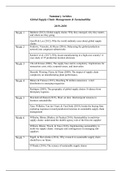Samenvatting
Samenvatting verplichte artikelen GSCM & Sustainability
- Vak
- Instelling
Deze samenvatting (51 pag.) bevat alle verplichte artikelen voor het vak van week 1 t/m week 7, te weten: - Baldwin (2012) - Global supply chains: Why they emerged, why they matter, and where are they going. - Gereffi & Lee (2012) - Why the world suddenly cares about global supply chains. - Ferdows...
[Meer zien]












